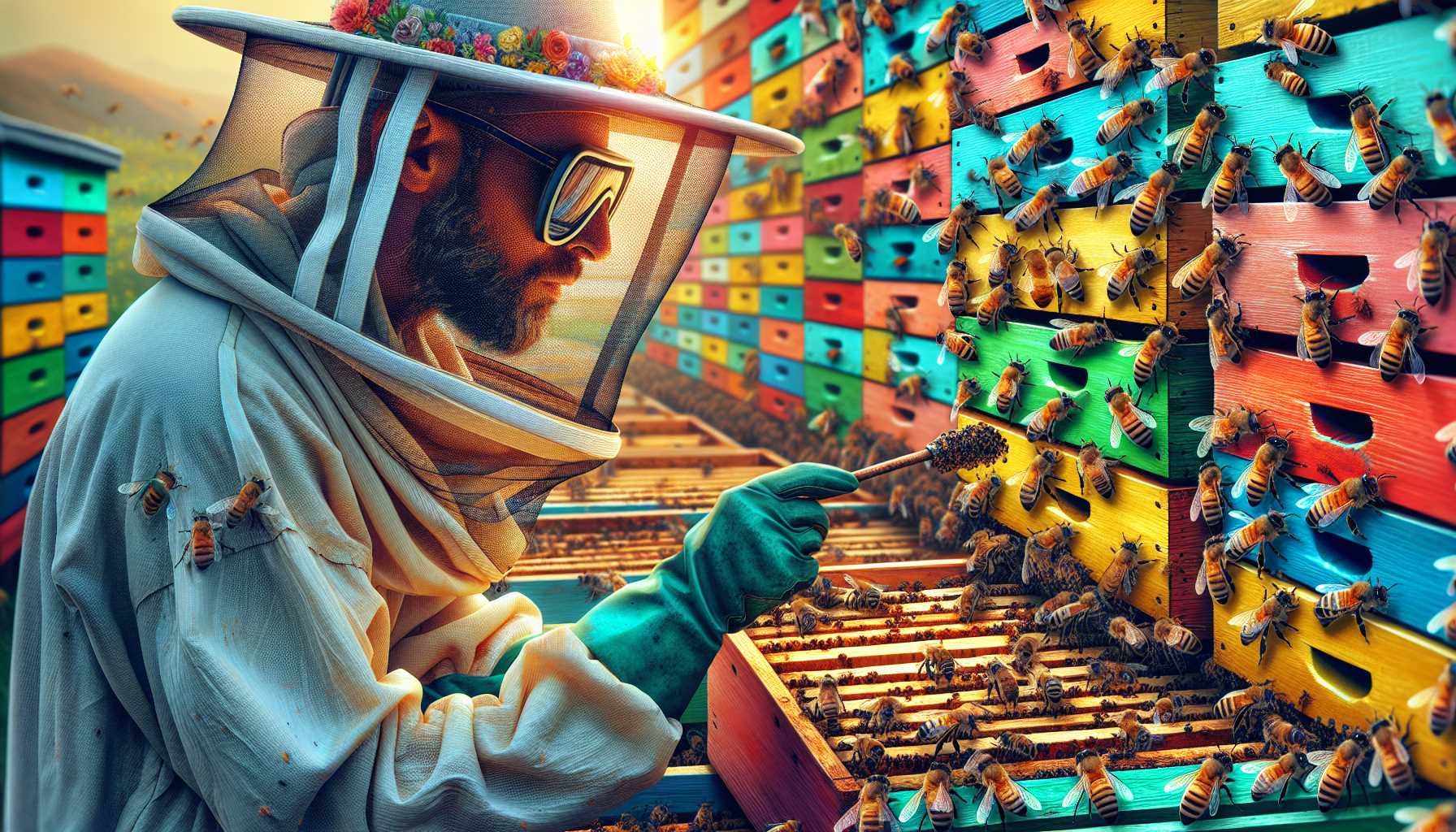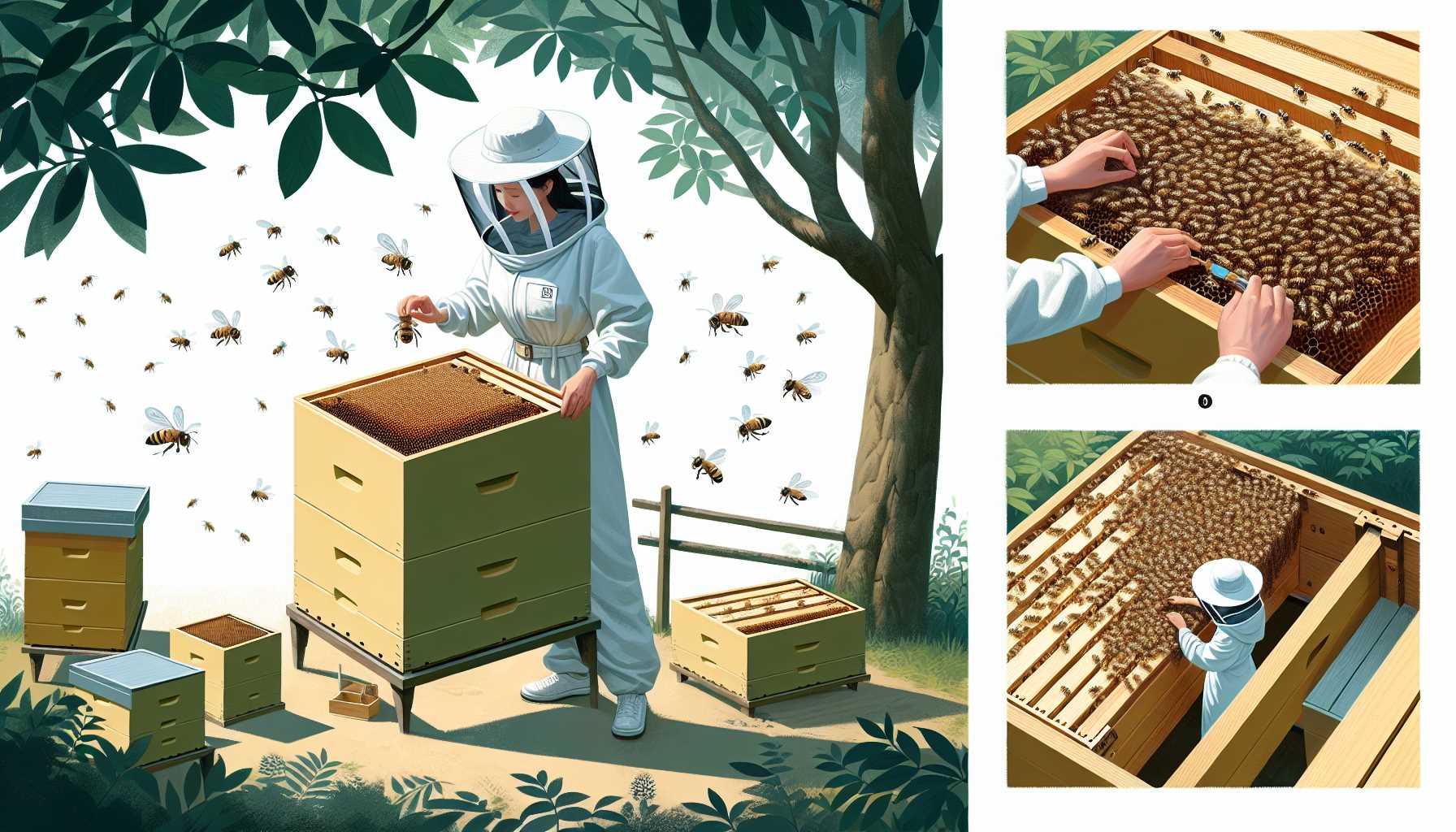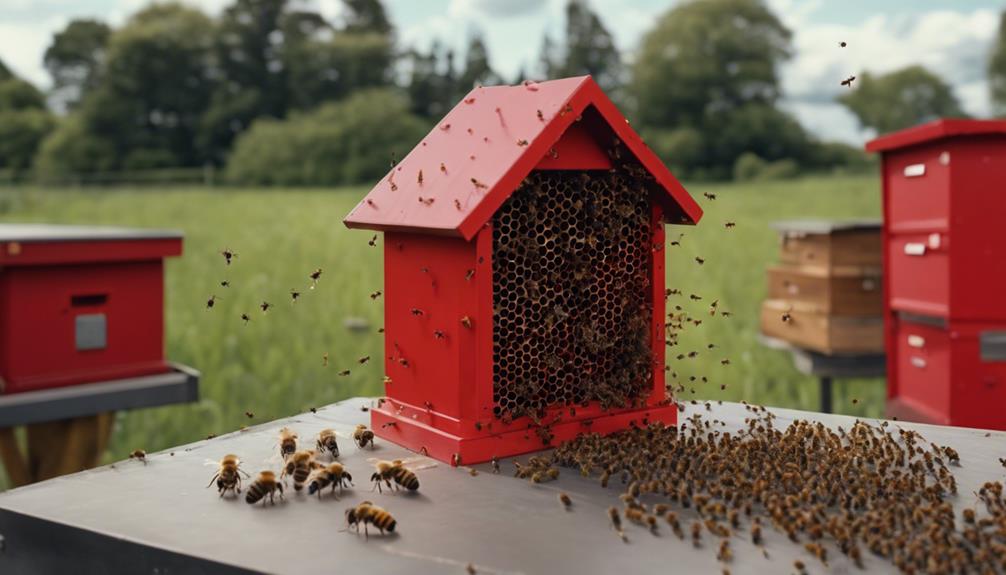Establishing a thriving beekeeping operation requires meticulous planning and execution. From selecting the optimal location for your hives to ensuring the health and productivity of your bees, each step plays a crucial role in the success of your endeavor.
However, there are five essential steps that stand out as fundamental pillars of starting your beekeeping journey on the right foot. These steps serve as the foundation for a sustainable and rewarding beekeeping experience, guiding you through the intricacies of hive management and honey production.
Key Takeaways
- Choose a suitable bee species and hive location for success.
- Monitor hive health regularly for optimal conditions.
- Handle honey extraction and beeswax processing with care.
- Prioritize hive maintenance and address issues promptly.
Selecting the Right Location

When choosing a location for your bee hives, prioritize access to adequate sunlight and protection from strong winds. Weather conditions play a crucial role in the success of your beekeeping venture. Bees thrive in environments with consistent sun exposure, as it helps regulate the temperature within the hive and promotes activity. Additionally, sheltering your hives from strong winds is essential to prevent stress on the bees and maintain the structural integrity of the hive.
Consider the landscaping requirements of your chosen location. Ensure there is a source of fresh water nearby for the bees to access easily. Avoid placing hives in low-lying areas that may become waterlogged during rainy periods. It is also vital to assess the surrounding flora to provide a diverse range of forage for the bees throughout the seasons.
Furthermore, be mindful of potential predators that could threaten your hive’s security. Select a location that minimizes exposure to common hive invaders such as bears, skunks, and raccoons. By carefully evaluating these factors, you can create an optimal environment for your bees to thrive and produce honey abundantly.
Choosing the Appropriate Hive Equipment

Selecting the appropriate hive equipment is a crucial step in ensuring the success and productivity of your beekeeping operation. When choosing hive equipment, it is essential to prioritize factors such as hive maintenance, cleaning, ventilation, and insulation to create a conducive environment for your bees.
For hive maintenance and cleaning, opt for equipment that is durable, easy to dismantle, and clean. Consider hives with removable frames for convenient inspection and maintenance. Proper hive ventilation is vital for regulating temperature and humidity levels inside the hive. Ensure your equipment allows for adequate airflow while also providing insulation to protect the bees from extreme weather conditions.
Hive equipment like bottom boards, hive bodies, frames, and covers should be selected based on the specific needs of your bee colony and the environmental conditions of your location. Investing in high-quality hive equipment will not only benefit the bees but also make your beekeeping experience more enjoyable and successful.
Obtaining and Introducing Bees

To further enhance your beekeeping journey after securing the appropriate hive equipment, the crucial next step is obtaining and introducing bees to your hive with care and precision.
Key Steps to Obtaining and Introducing Bees:
- Selecting the Right Bee Species: Before obtaining bees, research and choose a bee species that aligns with your location, climate, and beekeeping goals. Popular options include Italian bees, Carniolan bees, and Russian bees.
- Understanding Bee Behavior: Familiarize yourself with bee behavior to ensure a smooth introduction process. Bees are highly organized and follow a strict hierarchy within the colony. Knowing how they communicate, forage, and defend the hive will help you manage them effectively.
- Introducing Bees to the Hive: When introducing bees to the hive, do so gradually and gently. Techniques like the newspaper method or using a queen cage can help the bees acclimate to their new environment without causing agitation. Monitor their acceptance closely to ensure a successful integration.
Monitoring Hive Health and Progress

A critical aspect of successful beekeeping involves vigilantly monitoring the health and progress of your hive to ensure the well-being and productivity of your bees. Regular inspections are vital to assess the overall condition of the hive, the presence of pests or diseases, and the strength of the colony. The frequency of inspections may vary depending on the time of year and the experience of the beekeeper, but typically, beginners are advised to check their hives every 7-10 days during the active beekeeping season.
During inspections, beekeepers should look for signs of a healthy hive, such as a robust population, ample food stores, and a well-organized brood pattern. Any abnormalities should be addressed promptly to prevent issues from escalating. Additionally, hive maintenance tasks like replacing old combs, ensuring proper ventilation, and managing the hive’s cleanliness are crucial for the bees’ well-being.
Harvesting Honey and Hive Products

When preparing to harvest honey and hive products, beekeepers should follow proper techniques to ensure a successful and efficient process.
- Extracting Honey: Harvesting honey is a rewarding task that requires careful handling. Beekeepers should use a bee smoker to calm the bees before opening the hive for extraction. Once the frames are removed, the honey can be extracted using a honey extractor, ensuring minimal disturbance to the bees and the comb.
- Processing Wax: After harvesting honey, processing beeswax is another valuable aspect of hive product collection. Beekeepers can melt the beeswax using a double boiler method to avoid overheating. Once melted, the wax can be strained to remove impurities and then molded into blocks or used for various beeswax products like candles or balms.
- Storage and Preservation: Properly storing harvested honey and beeswax is crucial to maintain their quality. Honey should be stored in airtight containers away from direct sunlight to prevent crystallization, while beeswax blocks can be kept in a cool, dry place to avoid melting. Following these steps ensures that the fruits of the hive can be enjoyed for an extended period.
Frequently Asked Questions
How Can I Attract Bees to My Hive if They Are Not Naturally in the Area?
To attract bees to a hive in an area lacking natural presence, consider bee relocation services. Additionally, providing bee feeding stations can entice bees. Understanding bee population dynamics and colony establishment is crucial for success in establishing a thriving bee colony.
Can I Use Artificial Means to Monitor Hive Health and Progress, Such as Technology or Sensors?
Using technology for hive monitoring is beneficial. Sensors provide real-time data on hive health and progress. Artificial hive monitoring solutions offer insights to ensure bee colony success. Embracing tech solutions enhances beekeeping efficiency and productivity.
Are There Any Special Considerations for Introducing Bees to My Hive if They Are Being Shipped From a Different Location?
"Before introducing bees to your hive after relocation, ensure a quarantine process to prevent cross contamination risks. Monitor their health closely, as stress from shipping may impact their well-being. Remember, a stitch in time saves nine."
What Should I Do if I Suspect My Hive Is Being Attacked by Pests or Predators?
When suspecting hive pest or predator attacks, swift action is crucial. Implement effective pest management strategies to safeguard your hive. Enhance hive security with predator deterrents. Regularly monitor and maintain hive protection protocols for optimal bee colony health and productivity.
Are There Any Regulations or Permits I Need to Consider When Harvesting Honey and Hive Products for Sale?
Navigating the sweet world of honey sales requires a keen eye on permit requirements, legal restrictions, market regulations, and selling guidelines. Understanding the legal landscape ensures a smooth journey in sharing your hive products with the world.

Roger Thomas is a seasoned beekeeper and hive architect with a deep-seated passion for sustainable living. His fascination with bees has shaped his professional career, giving him practical and theoretical expertise in bee behavior, colony health, and optimal hive conditions. Roger’s technical skills shine in his bespoke hive creations that cater to the specific needs of diverse bee species, while his sustainable practices promote environmental balance and the wellbeing of the bee population.
As he continues his journey in beekeeping, Roger has become a dedicated advocate for responsible practices and an insightful educator in his field. His posts aim to inspire new beekeepers, underline the importance of sustainability, and showcase the remarkable contribution bees make to our ecosystem. Roger invites you to join him as he delves into the world of bees and the rewarding, honey-sweet art of beekeeping.


